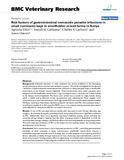Risk factors of gastrointestinal nematode parasite infections in small ruminants kept in smallholder mixed farms in Kenya

View/
Date
2007-04-20Author
Odoi, Agricola
Gathuma, Joseph M
Gachuiri, Charles K
Omore, Amos
Type
Journal ArticleMetadata
Show full item recordAbstract
Abstract
Background
Helminth infections in small ruminants are serious problems in the developing world, particularly where nutrition and sanitation are poor. This study investigated the burden and risk factors of gastrointestinal nematode parasite infections in sheep and goats kept in smallholder mixed farms in the Kenyan Central Highlands. Three hundred and seven small ruminants were sampled from 66 smallholder mixed farms in agro-ecological zones 1 (humid) and 3 (semi-humid) in the Kenyan Central highlands. The farms were visited once a month for eight months during which a health and production survey questionnaire was administered. Fecal samples were collected at each visit from each animal. Fecal egg counts (FEC) were performed using the modified McMaster technique. Associations between potential risk factors and FEC were assessed using 3-level Poisson models fit in SAS using GLIMMIX macro. Correlations among repeated observations were adjusted for using three different correlation structures.
Results
A rise in FEC was observed two months after the onset of rains. Farmer education, age category, de-worming during the preceding month and grazing system were significant predictors of FEC. Additionally, there were significant interactions between grazing system and both de-worming and age category implying that the effect of grazing system is dependent on both de-worming status and age category; and that the effect of de-worming depends on the grazing system. The most important predictors of FEC in the study area were grazing system, de-worming status and education of the farmers.
Conclusion
Since several factors were important predictors of FEC, controlling gastrointestinal helminths of small ruminants in these resource-poor smallholder mixed farms requires a sustainable integrated helminth control strategy that includes adoption of zero-grazing and more farmer education probably through extension services. Achieving improved helminth controls in these resource-poor farming systems offers an opportunity to increase small ruminant productivity and hence has a potential of improving the livelihood of the resource-poor farmers.
URI
http://dx.doi.org/10.1186/1746-6148-3-6http://erepository.uonbi.ac.ke:8080/xmlui/handle/123456789/14772
